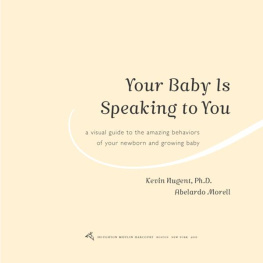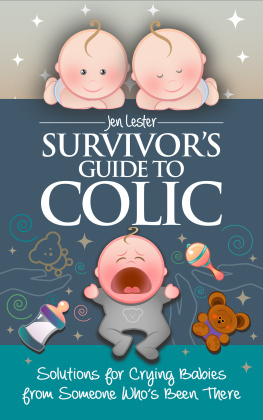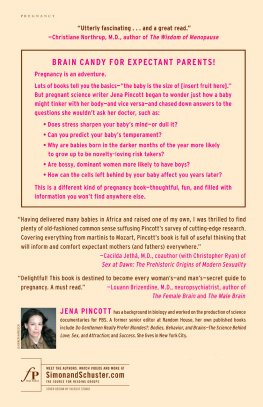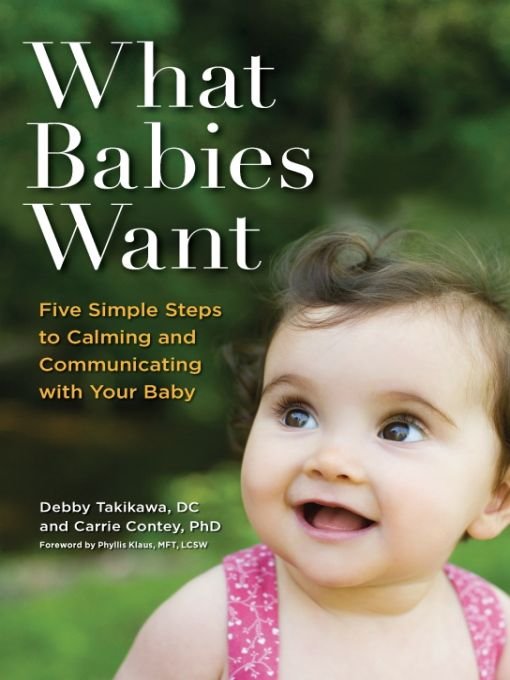Table of Contents
We dedicate this book to our parents,
partners, and children (present and future),
and the real-life experiences of relationships
weve shared together.
Foreword
It is a pleasure to write the foreword for this special book. It is simple but profound, small but filled with important information. In What Babies Want, Carrie Contey and Debby Takikawa help parents understand the needs, moods, changes, and rhythms of their infants. Parents learn how to help their baby move from being distressed to a calmer state.
There is wisdom in recognizing your own feelings when entering your childs world. Babies responses are like a barometer to their parents or caretakers emotions. New research has shown that during the whole first year of life there are transfers in emotions and physiological reactions from the right brain of the mother to the right brain of the baby.
All emotional responses have value. All become available from the early development of the limbic system in the womb. Emotions are protective. When an infant is upset, it means that something doesnt feel right at a basic level of survival. Infants cannot put an intellectual meaning to their emotions; they can only feel them throughout their bodies. When overly upset their heart rate goes up, stress hormones increase, and their little systems struggle to handle what may appear to them to be danger.
Unlike us, an infants system is more fragile. It is immature and doesnt re-regulate quickly. If a baby is stressed too long, he or she may look quiet, but in reality could be having a micro-depression. The immune system can be lowered, and other reactions, such as tummy aches, can occur. It is truly important to recognize messages from your baby when he or she is upset. These messages are not verbal nor understood intellectually by the baby; they are felt experiences. The baby needs your help to return to a more stable state. This book provides an easy-to-follow method to do this.
Contey and Takikawa, both knowledgeable caregivers, teach parents how to respond sensitively to their infants, by first being aware of their own feelings, and then by using simple ways to reduce stress, even under trying conditions. The authors show how to acknowledge the babys experience through gentle mirroring and a variety of other useful methods that will help the baby return to a calmer state.
These thoughtful, helpful methodschecking in with ones self and taking a moment to settle, listening to what the baby is communicating, reflecting back what you are perceiving, then offering comfortare the basis of good communication. When practiced, they allow parents to work together in mind, body, and emotion to validate a sense of self in the baby. This type of care creates deep and lasting bonds between parents and their children.
PHYLLIS KLAUS, MFT, LCSW
Coauthor:
Your Amazing Newborn
Bonding: Building the Foundations of Secure Attachment and Independence
The Doula Book: How a Trained Labor Companion Can Help You Have a
Shorter, Easier, and Healthier Birth
Introduction
Around the time of birth, for a few precious moments, we are sometimes able to tap into something so ancient, primal and wise, that we are able to transcend our limited view of whats possible.
NOAH WYLE, NARRATION, WHAT BABIES WANT, THE MOVIE
Welcome and congratulations on the arrival of your new baby. We are honored to share this book with you and hope it will provide guidance and inspiration during this tender time of life and beyond.
It is an exciting time to be a new parent. We know more about babies and development than ever before. In fact, there is a revolution taking place in the way we think about and care for babies. At the core of this transformation is the understanding that your baby is a person who arrived from the womb with likes and dislikes, feelings and opinions, and an incredible ability to understand and communicate with you. Pause for just a moment and think about the fact that your baby is a whole person. When you keep this in mind, it changes how you are with your baby.
This book is for parents as well as anyone who will be interacting with your baby. It is intended to be an accessible, concrete guide to understanding how to be with your baby in ways that support both of you as you create a deep and loving relationship right from the start.
CALMS is a simple five step approach to support parents and caregivers to calming and communicating with their babies. The five steps of CALMS are:
Check in with yourself.
Allow a breath.
Listen to your baby.
Make contact and mirror feelings.
Soothe your baby.
We have divided this book into six parts. In Part I, we will guide you through the CALMS steps and provide the hows and whys of the method. We will also introduce you to Anna, Mike, and their baby Joshua to illustrate how CALMS can be applied in real life. Part II will offer basic information about human development. In Part III, we focus on early brain development, bonding, and attachment. Part IV addresses the challenges that can happen around birth and guides you in applying the CALMS method for building your relationship with yourself, your baby, and your family. In Part V, we explain how babies communicate and develop language. In this section we provide examples of ways to connect with your little one. Finally, in Part VI, we offer the answers to some common questions about the CALMS method.
Please note that we have alternated the use of he and she in each section so that it feels personal to all readers.
We have had a wonderful time putting our hearts and heads together to create this book, which honors your baby and your entire family. We respectfully present these ideas to you and hope that our words will be helpful as you find your way into 0parenthood.
DEBBY AND CARRIE
PART ONE
CALMS: Five Simple Steps to Harmony
Making the decision to have a child is momentous. It is to decide forever to have a heart go walking around outside your body.
ELIZABETH STONE, AUTHOR
Anna and Mike are the new parents of Joshua, who is now four weeks old. They had a long, hard labor and birth, but there were no serious complications; they came home from the hospital the next day. Joshua is an adorable newborn, with a little crest of black hair, pink cheeks, and sparkling eyes. From his first day at home, Joshua tended to be a bit sensitive about any changes in his routine, and would cry and struggle as he tried to go to sleep. He often woke up crying or fussy. In spite of this, he usually slept a lot and was able to soothe easily with breastfeeding, bouncing, and being carried in the sling. Although they were starting to feel the effects of sleep deprivation, Anna and Mike were having a wonderful time falling in love with this magnificent new baby. Life with Joshua suited them, and after two weeks of being home, Mike was sad about having to return to work.
Since Mike went back to work, Anna has been home alone with Joshua most days. At first, things went smoothly, but as the days go on, Anna has grown more tired and Joshua has grown fussier. The late afternoons have been particularly challenging for both of them. For several days now, Joshua has been crying for over an hour; none of Annas soothing and calming techniques seem to be working. Trying to handle this alone has not been easy for Anna, and she is wondering if she is doing something wrong, maybe spoiling him with too much attention. She is beginning to lose her confidence as a mother as Joshua gets harder and harder to console.













